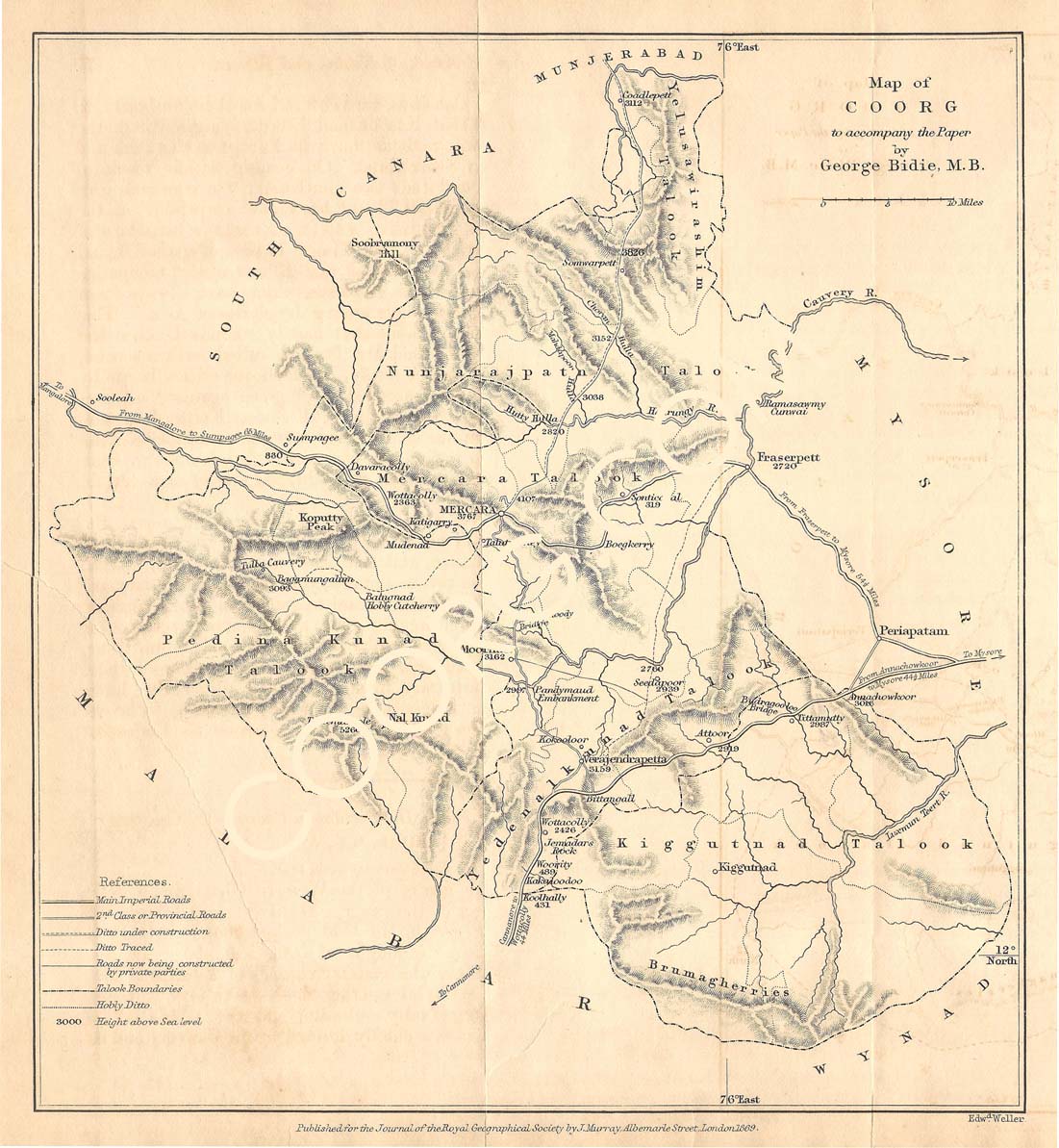Image: Map of Coorg, 1869 . Dr.George Bidie submitted this map with his paper to the RGS. Image from a private collection.
Here is an interesting paper which was submitted by Dr. George Bidie to the RGS with the first cartographic map of Coorg, 140 years ago.
Profile of Dr.Bidie.
Dr. George Bidie : CLE., M.A., M.B., F.L.S., F.R.C.S.E., Surgn.-Gen. Late Madras Medical Department,(1830 – 1913)
Dr. George Bidie was born in Banffshire,UK. Educated at the University of Aberdeen ; joined the service, 20th Feb., 1856; employed from June, 1859, as civil surgn. of Guntur, Medical officer of the Mysore farm commissariat establishments., profressor in the Medical college Madras,; served in Mysore and Coorg, 1867-68, on special duty in the coffee districts ; secy. to surgn -gen., 1870-72, and again in 1880-84 and 1884-85; supt. of the govt, central museum, 1872-84,and 1885; on special duty in connection with cinchona commission., 1873; fellow of Madras univ., 1879; served in public dept., 1883, in connection with Calcutta exhibition. ; ! sanitary commisioner., Madras, April, 1885; surgn. gen. with the govt, of Madras, Oct., 1886; retd., April, 1890; in 1891, acted as Madras delegate at the international congress of hygiene and demography, and drew up an abstract of its proceedings; K.H.S., Feb., 1898; author of numerous publications connected with the botany and zoology of Madras province.
Effects on Climate of Forest Destruction in Coorg.
By George Bidie M.B.
From: The journal of the Royal Geographic Society of London, Volume 39.
January 25th, 1869.
Coorg lies near the centre of the Western Ghats, and chiefly on the eastern aspect of the range. On its western margin the crests of the chain rise up in bold peaked mountain masses, some of which attain the height of 5000 feet above the sea, and to the east of these the country consists of a series of low, long-backed hills, with intersecting deep-set valleys, running out towards, and gradually subsiding in, the table-land of Mysore. The province is chiefly drained by the Cauvery and its tributaries, but several large streams descending to the western coast of the peninsula also have their origin in it. The Cauvery rises far to the west, and for the first 10 miles or so of its course passes down the centre of a broad, flat-bottomed valley, surrounded on three of its sides by steep lofty hills. Contrary to what might have been expected, this large basin contains but little forest, so that the heavy rain-fall that descends on it must at once be precipitated into the river. The average elevation of Coorg is about 3000 feet above the sea, and at no distant date nearly the whole province appears to have been covered with forest. Towards the west, the remaining forest is, as a rule, dense and lofty; but at a distance of 10 miles from the crest of the ghats it begins to get less so, and at 12 miles we enter the bamboo district, in which the trees are smaller and the jungle more open. The nature of the forest, and also the kinds of trees found in it, form pretty accurate indexes of the amount of rain-fall. Thus in the dense jungle tract, the annual fall varies from 120 to 150 inches, while in the bamboo district it ranges from 60 to 100 inches. As to the flora, the characteristic trees in the dense jungle are Michelia (Chumpak),Mesua {Iron-wood), Diospyros (Ebony and other species), Calophyllum angustifolium (Poon spar), Cedrela toona (White cedar),Chickrassia tubularis (Red cedar), Dipterocarpus, Garcinia, Artocarpus, Canarium strictum (Black Hammer Tree), Euonymus, Cinnamonum iners, Myristica, Myrtacese, Vaccinium, ‘Melastomaceae, three species of Kubus and a rose. In the shade of this forest there is a dense under-growth of moisture-loving plants, such as cardamom, canes, areca, plaintain, tree and other ferns, wild pepper and arums, and the boughs of many of the trees are covered with splendid orchids. The line that indicates the commencement of the bamboo district is marked by the absence of ferns, and the prevalence of a small shrub, Ardisia. The forest in it has a very characteristic appearance from the large clumps of bamboo that send up their feathery stems in all directions, and the most common trees are the Dalbergia latifolia (Black wood), Pterocarpus marsupium (Kinotree), Terminalia coriacea (Mutti), Lagerstromia parviflora (Benteak),Conocarpus latifolius (Diridul), Nauclea parviflora, Bassia latifolia, several Acacias, Butea frondosa; and in the eastern portion of the tract, Teak and Sandal-wood. This forest is not continuous, but interspersed with beautiful grassy glades, and in its shade the ground is covered with good pasture-grasses, and gay annuals spring up everywhere during the rains.
The rain in Coorg may be said to be derived entirely from the south-west monsoon—the showers at other seasons being few and light—and is chiefly deposited between the 1st of June and the end of September. During that period the heated plains of Central Asia cause a steady indraught of the southeast trade winds, rendered westerly by the diurnal rotation of the earth, and as these pass over an immense expanse of ocean ere they reach the land, they become heavily charged with moisture in their course. Shortly after quitting the sea, they encounter the western ghats, standing right across their track, and drop upon them and the low country to the west of them, the greater portion of their watery freight. The chief cause of the precipitation is the reduction of temperature produced by the warm moist air coming in contact with the colder hills, and by the decrease in density that ensues as the current rolls up the mountain side. It will thus be seen that the rain-fall in Coorg depends entirely on its geographical position and geological conformation. In other words, it is so located that it is traversed by the south-west monsoon at the time when that wind is most densely charged with moisture, and so elevated as to obstruct its current and cause copious precipitation. Under such circumstances it can be of little consequence, as regards the rain-fall, whether the mountain slopes are bare or clothed with dense forest, as neither condition could have any appreciable influence on the amount of precipitation, or on the course or duration of the monsoon. I look, therefore, on the forests that grow on these high-lands as a consequence, and not the cause, of the rain; and this view is supported by the change that takes place in the nature of the forest as we proceed eastward from the crest of the ghats and the rain-fall diminishes, the gradual diminution being easily accounted for on purely physical grounds. It does not appear therefore that the annual rain-fall in Coorg has or can be sensibly diminished by the destruction of forest which has taken place.* At the same time it must be stated that the Natives of the district complain that of late years their country has become hotter and drier from want of rain, and that rice crops have been diminished or lost from a failure of water in streams that used to run throughout the year. These changes they attribute to the cutting down of forest on coffee estates, and it will, therefore be necessary to enquire what effects the destruction of forests actually may have had on the climate and streams of the country. In so far as regards the rain-fall, the subject has been already discussed, so that it only remains to notice its bearing on other elements of climate and on the drainage.
* It would have been well if this view could have been supported by records of the actual rain-fall during the last fifteen or twenty years, but unfortunately, prior to the beginning of 1863, no reliable observations appear to have been made. At present there are gauges at three stations, watched by careful observers, and the results, so far as communicated, are given in an Appendix ( i shall updated the appendix shortly ).
It is only since the advent of the European planter, or during the last 12 years, that felling of forest to any considerable extent has taken place in Coorg, and as the clearing has progressed in annual instalments of comparatively small extent, the results have crept on gradually, so as to render them much less obvious than if the entire extent had been cleared in a single season. There can be no doubt, too, that the evil influences called forth by forest destruction do not attain their full force immediately, but go on increasing from year to year until they acquire a most disastrous power. The total area of land denuded of forest in Coorg to make way for coffee amounts to about 20,000 acres,* and the clearings have mostly been made in the dense jungle tract, although a good many estates have of late years been opened out in the bamboo district. The spots that have been selected as sites for estates are chiefly situated on the flanks and crests of low hills, the sides and bottoms of ravines, and the slopes and passes running down on the western side of the ghats to the low country. Such localities, as a rule, are densely wooded, and being well supplied with springs, give rise to numerous small streams. In fact, they may be looked upon as the fountains of the river system of the country. The question then arises—to what extent are springs and streams in such situations dependent on the forest for their supply of water, and what will be the effect on them of its removal ? It is, perhaps, hardly necessary to say that springs and small streams are fed by the water stored up in the earth during the rainy season. As the rain descends on natural forest, it is conveyed in various directions by the leaves towards the ground, and on reaching this prevented from running rapidly off by the dense undergrowth of shrubs and herbaceous plants, and a carpet, of dead leaves. Below this it encounters a layer of vegetable mould, which, having a great affinity for moisture, absorbs it like a sponge. As soon as the humus is fully saturated, it passes on what water may subsequently fall to the subjacent mineral earth, and this process of percolation is in various ways aided by roots which descend to great depths, perforating the densest subsoil, and even forming passages in rock. The quantity of water thus transferred to the depths of the earth and the reservoirs of springs is enormous, and when the dry season arrives, the forest again plays an important part
* This represents the total acreage according to returns from individual planters.
by husbanding and giving off gradually the subterranean supplies. The means by which these beneficial influences are exerted are various and interesting. As the water rises to the surface, it is, as in the case of its descent, again partially retarded bv the layer of humus, and, having passed through that, so obstructed by various mechanical obstacles, that it does not readily acquire the volume of a stream, and so pass quickly away. The way in which the soil is matted together by roots in forests also renders it very difficult for a small stream to cut out a channel; and when such has been formed, it is in general so tortuous, and the current so slow, that it must lose a considerable amount of water by percolation. At the same time, the shade of forest greatly restrains evaporation, and although the quantity of water taken up and exhaled by trees is very great, a portion of it is returned as dew or fog, and what is wafted away is fully compensated for by other advantages resulting from the presence of forest. The influence of shade in modifying evaporation is well illustrated by what happens in the coffee districts after the April showers which herald the advent of the south-west monsoon. On an estate freely exposed a day or two of sunshine after a heavy fall will have rendered the soil quite dry and hard again, whereas on an estate under forest shade the ground will continue damp for a week or more. Although their insignificance might lead to their being overlooked, there can be no doubt that the mosses, lichens, and succulent herbaceous plants, which abound in tropical forests, are also of considerable benefit in retaining moisture, as, during rain, they absorb water like a sponge, and part with it again very slowly. It would, therefore, appear that there are numerous agents and conditions in natural forests favourable to the production and permanence of springs and streams, which are not to be found in open ground, originally so or denuded of its trees by man. During the whole of my tour in Coorg and Mysore, I have endeavoured to collect information bearing on this important question, and the facts thus elicited on the whole go to prove that tropical forest is the alma mater of springs and streams. Various instances have been brought to my notice of springs and small streams having become quite dry since the forest was cleared away in their neighbourhood, while in numerous cases those that used to be perennial only contain water now during, and for a short period after, the monsoon. Similar results have been found to follow the destruction of forest growing near the sources of streams in all parts of the world. Thus Palestine and other eastern countries have been rendered desolate by the destruction of the forests that existed in them when they were so famous for their beauty and fertility, and in modern times many districts in France and America have had their water-supply diminished, and fertile land converted into arid wastes by the clearing away of woods around the head waters of streams* In a recent Mauritius paper, it was stated that the culture of the sugar-cane had of late become so precarious in the island, owing to the excessive dryness of the air and soil, consequent on the cutting down of forests, that the Government had considered it desirable to appoint a Commission to investigate the matter and suggest some remedy. For some years, too, the nutmeg-trees in Singapore have been dying, and so extensive, obstinate, and fatal has been the ” blight,” that at the present day not one of the numerous plantations there is considered worth the expense of cultivation. A most graphic account of the disaster will be found in Cameron’s ‘ Malayan India,’ and judging from the information there given as to the cutting down of forest to make way for the nutmeg, and the manner in which the trees died, there seems every reason to believe that their death was accelerated, if not entirely induced, by the reduction of humidity resulting from extensive clearing.
The next points that require to be considered in connexion with forest clearance are its effects on the drainage of the denuded district, and the results that these in their turn induce. When land is being cleared for coffee culture, the woods and their under-growth are cut down and burned; and during the conflagration, not only is the ground deprived of its carpet of vegetation, but a portion of the humus consumed, and the remainder so dried that it is liable to be washed away. When rain falls on such ground, instead of being delayed and gradually conveyed into the soil, it at once rushes down the bare slopes, enters the nearest nullah, and is rapidly carried out of the district. At the same time a certain portion of the surface soil is carried away, the conservative agencies of the forest being no longer in existence. The effects of this degrading process, continued through a series of years, may be well seen on the crests and slopes of some of the lower hills in Coorg, in what is called grass or banay land. In such situations nothing is left but the barren, stony subsoil, covered by a coarse grass, or bearing a few stunted shrubs of some hardy description. The most striking results of clearing, however, are the channels cut out in new situations by the rain water as it seeks a lower level, and the landslips caused by percolation behind banks of earth, which have no longer the binding influence of tree-roots to keep them in position. The nullahs, too, or natural watercourses, which used to be sufficient to carry off the surplus water, are no longer so, and an impetuous torrent dashes down them, eroding their banks and carrying along with it not only earth, but stones often of considerable size. These results were very forcibly pointed out by Major Sankey in his .Report on the Public Works in Coorg for the official year 1865-66, in which he shows that great damage has of late years been done to roads and bridges in the Province by the floods resulting from forest clearance. This Eeport drew the attention of the Eight Hon. the Secretary of State for India to the subject, and in July, 1866, he forwarded a despatch to the Government of India, which induced them to suggest to the Madras Government the necessity for a further inquiry into the effects of these freshets, and thereupon tliey requested the opinion of Dr. Cleghorn, the Conservator of Forests, on the subject. Accordingly, in August 1867, when the monsoon was in full force, he proceeded to examine the Cauvery, which, as already stated, drains the greater portion of Coorg. The point of observation was the junction of the Cauvery and Bhowani Rivers, but no trace of unusual flood could be detected there; and Dr. Cleghorn also states in his Report on the subject, that the water returns for twenty years from the Tanjore district, which is irrigated by the Cauvery, do not show any material alteration in volume. Dr. Cleghorn’s most interesting Report was published in Proceedings of Madras Government, Revenue Department, dated 23rd September, 1867; and since the commencement of this inquiry, it has been repeatedly brought to my notice as being opposed to Major Sankey’s views, and the theory in general of floods in rivers being a result of destruction of forest. A brief explanation, however, will, I think, show that Dr. Cleghorn’s observations do not in the slightest degree affect the question at issue. Before the Cauvery reaches the place where it was watched by him, it receives numerous tributaries from other districts, which swell it to such a size as would render any increase of water from Coorg hardly appreciable; and it is also between Coorg and Coimbatore frequently tapped by irrigation canals, which have a considerable modifying influence on the volume of rivers. It is also worthy of notice that the forest immediately on the banks of the Cauvery, while it runs in Coorg, remains almost intact, and that the drainage of a large extent of the cleared land does not flow into it, but is carried off by streams running to the western coast of the peninsula. The effects, therefore, of forest destruction in Coorg, as regards floods, would be chiefly local, and most apparent in the very spots where they were noticed by Major Sankey, viz., along the course of tributaries of the Cauvery and of other streams arising in, orpassing through, denuded tracts of land. At the same time, there can be no doubt that, if the clearing is greatly extended, its effects will ultimately become apparent in rivers far beyond the limits of the province.
* See ‘Brown’s Forester,’ p. 13, 3rd edition, 1861, and ‘Man and Nature,’ bv Marsh, pp. 197-210, &c, 1864.
The effects of forest clearance on various climatic phenomena are also of great interest and importance, and I shall now briefly consider its influence :—
A.—On composition of air.
B.—On temperature of air.
C.—On humidity of air.
Before entering on these topics, it may be as well to premise that here again the results of the denudation will be chiefly local; for although the air that yields its carbon may come from afar, and the oxygen made in this great forest laboratory may be carried to a great distance, still these changes must, under present circumstances, be to the atmospheric sea of the peninsula but as those .effected by a small river of water in the Indian Ocean. In the same manner changes in the moisture or temperature of the air can hardly extend to any great distance from the site of the clearing.
A.—Influence Op Forest Clearance On The Composition Of The Air.
Although opinions differ as to the whole of thechanges produced in air by living plants, still all agree that they are the chief agents in keeping up the supply of oxygen, which, amongst other useful operations, supports the process of decay in organic substances, whereby their constituents are utilised in the economy of nature, and produces those beneficial changes in the soil which follow digging or ploughing. Trees also absorb various gases generated during combustion and decay, and so at the same time purify the air, and increase their own vigour and substance. Their influence with respect to malaria is also very considerable. If this subtle atmospheric element arises from a marsh fed by the ooze from neighbouring forest, or from the decaying vegetable matter in forest shade, the cutting down of the trees may bring about a beneficial change. In some cases the first effect of the clearing is to increase the malaria, the processes that caused its evolution being apparently stimulated thereby; but as the marsh becomes dry ground, and the vegetable matter is converted into humus and covered with grass, the neighbourhood becomes much healthier. In the case of drifting malaria again, trees growing between its source and human habitations act as a screen, arresting its progress mechanically, and probably also decomposing it to some extent On the whole, as regards malaria, the climate of Coorg does not appear to have been changed for the better or worse by the destruction of forest in the province.
B.—Effects Of Clearing On The Temperature of The Air And Ground.
One has only to pass during the heat of the day from a clearing in Coorg into the nearest forest to be sensible of a great change in temperature, and although the cool sensation thus experienced is greatly owing to the leafy screen keeping out the direct rays of the sun, still it is well known that the temperature of the air in forest is lower and more equable than in clearings. In Singapore, ” by resorting to the neighbourhood of the jungle, a degree at least of reduction in temperature may be secured.” During the night there ” soft land airs ” breathe from out the jungle, and ” to these land winds is due, in a great measure, the coolness of the nights, wlrich will generally admit of good sound slumber.” * The exact frigorific influence of forest in the tropics does not appear to have been much inquired into, and it is therefore very desirable that careful observations should be instituted, so as to afford reliable data. As regards the temperature of the ground, the mean temperature of forest land in the tropics has been ascertained to be nearly 2° Fahrenheit lower than that of clearings. It is interesting to note that these statements are supported by the nature of the flora that springs up in neglected clearings in Coorg, the plants being entirely such as grow in hot dry situations. Forest reduces the temperature of the air in various ways, but chiefly by transpiration, heat being rendered latent when the fluid taken up from the ground is passing into the state of vapour. The amount of water exhaled in this way is enormous, a sunflower having been found to give off from 20 to 30 ounces daily. The moist state of the ground in forest shade must also cause some reduction in temperature, while the radiation that goes on from the leaves will, during a portion of the twenty-four hours, render them frigorific agents. Trees, as mechanical agents, keep the ground from being heated, and greatly prevent aerial currents, which, in the open, produce sudden and notable changes in the temperature. Judging from its effects on the original flora of the province, there is good reason for saying that the local climate in various parts of Coorg hag been rendered both hotter and drier by the destruction of forest. Thus various instances were brought to my notice of jungle-trees of the hardiest description having perished
* Cameron’s ‘ Our Tropical Possessions in Malayan India,’ p. 133.
in the neighbourhood of clearings, and no other cause could be discovered for their death beyond the obvious and popular one of change of climate. I have observed, too, that for some distance around denuded tracts, delicate ferns and flowering herbaceous plauts gradually disappear.
C.—Effects Of Clearing On The Humidity Of The Air And Soil.
Although a tree under certain conditions will absorb moisture from the air, still the amount thus withdrawn is as nothing compared with what it gives off by transpiration. By a beneficent arrangement, too, the amount of exhalation increases, within certain limits, in exact ratio with the heat and dryness of the air, and thus the severity of the hot season is partially mitigated. Plants in the immediate neighbourhood of forest, even although enjoying no shade, show by the colour and luxuriance of their leaves, that they are living in moister earth and air than those at a distance. As regards the soil, it is always very much damper in forest than in open ground ; and this fact has been frequently brought to my notice by European and Native planters, as indicative of the value of shade in coffee culture, is unnecessary to enter into the reason for this, as it will be sufficiently obvious from what has been already said in a former paragraph of this paper. Forests are of great benefit to cultivated plants in their neighbourhood by promoting the deposition of dew, and causing fog. They also obstruct the passage of drifting fogs, and so make them part with some of their moisture; and when a dry scorching wind sweeps over a damp wood, it is moistened, and rendered much less hurtful to vegetation. Again, when a cultivated valley lies at the base of a forest-clad hill, the moist stratum of air above the trees rolls down the slopes to it in calm nights, covering each leaf and blossom with copious dew. So far as ascertained facts enable us to judge, there are no grounds for believing that the forests on the Western Ghats ever induce showers. At the same time, many in the coffee districts believe that they have a considerable influence over the partial showers that fall now and again during the dry season, and it is better, perhaps, that the question should remain an open one, until further observations shall have thrown more light on the subject. That the cutting down of forests in Coorg has rendered both the earth and air there drier, is clearly shown by perennial streams having become periodical, by many plants perishing that used to flourish during the dry season, and by other remarkable changes in natural phenomena. Having thus discussed the changes in climate caused by forest clearance, it may be well to notice briefly its effects on animal and vegetable life.
Effects Of Forest Destruction On Animal Life.
It is not my intention to enter fully into its effects on man, but it may be remarked that the food supplies of the natives of Coorg may have been reduced by the departure of large game from the want of cover, and by a decrease in the rice crops from diminution in the water supply. As regards animal life in general, we know that in the natural forest there is a balance maintained between creatures that are harmless or useful and those that are hurtful. Thus the large carnivora keep in check bison, deer, &c, and the smaller ones hares, rats, &c, while small quadrupeds, birds, and snakes, directly or indirectly, prevent the undue increase of insects. These last are, of all the inhabitants of the forest, the most destructive when they become numerous, although, when kept within due bounds, very useful in getting rid of decaying organic matter, etc. In the natural forest insects rarely multiply to such an extent as to become destructive to trees or to the cultivated plants in the neighbourhood ; but when clearings are made, noxious species often appear in such numbers as to become a pest. The chief causes of the increase are the diminution of their enemies, the establishment of climatic and other conditions favourable to their production, and the absence of the plants on which they used to ive. In Coorg the appearance of the ” coffee borer ” in such hordes would seem to depend, to some extent, on the extensive clearings that have been made. Residents there have told me, too, that several birds and a gecko belonging to the fauna of Mysore have made their appearance in the province of late years, and at the same time various species of indigenous birds, which live in sparse jungle or open country, have become more numerous. The kinds that have multiplied most are chiefly insectivorous, such as the mina; and in this we see a beneficent arrangement on the part of nature to keep in check those enemies of vegetation, which climatic and other changes have called forth in devastating hosts.
Effects Of Forest Destruction On Vegetation.
These have been partly noticed in discussing the effects on climate. The most remarkable change has been the increase in species that formerly grew only in hot and barren situations in the province. Thus we have in clearings several kinds of Ficus, 2 Macarangas, Sponia Wightii (charcoal tree), 2 Solanums, Clerodendron infortunatum, Callicarpa cana, several grasses, &c, all naturally inhabitants of pasture-land. At the same time, several moisture-loving plants, such as Ferns, Aroideae, Canes, wild Plantain, Cardamom, &c, have become much less common, or disappeared in various tracts. The Solanum rubrum, probably an importation from Mysore, has become common in some places, and, but that its fruit is eagerly eaten by the mina and other birds, would soon be a most troublesome weed. An exotic, the Physalis peruviana, which must have escaped from some garden, has also increased in a wonderful manner, growing spontaneously in clearings all over the country. The plant that has been most influencea, however, by forest destruction, is the ” white weed,” or Ageratum cordifolium. This weed pursues the footsteps of the planter wherever he goes, springing up as if by miracle all over his clearings, robbing the soil of its most valuable constituents, and refusing to be exterminated.
The economic value of forest, perhaps, hardly lies within the scope of this Report; but I may be allowed to remark that the demand for wood is so steadily on the increase, that in a few years supplies will have to be drawn from remote districts, which as yet have hardly heard the sound of the axe. As the reserves of timber-trees now in favour decrease, too, doubtless substitutes for them will be eagerly sought after, and thus a good deal of what is termed ” jungle-wood ” may ultimately become of considerable value. It seems highly desirable, therefore, that forests containing trees of recognised or probable utility, should be preserved to meet the wants of the future, and that the State should be the owner of such reserves, as their safety can never be depended on when they pass into private hands. This would not prevent their being rented out for the culture of cardamoms or of coffee under shade.
It now remains to offer some remarks regarding the amount and locality of tracts of forest that should be preserved to save the climate from further deterioration, regulate the drainage, and maintain the famed fertility of Coorg. Running a line from Mercara in the north by Moornad, and due south until it touches the crest of the ghats, we have to the west of this a large and well-defined basin, in which the Cauvery and some of its tributaries arise. Only a very few clearings have been made in this tract, and the land, as a rule, is in the hands of the Coorgs, who seem anxious that the standing forest, of which there is a great deal, should be left untouched, and the district kept sacred to them and their descendants. One can sympathise with them in these wishes; and for other substantial reasons, I would strongly recommend that forest destruction should be strictly prohibited in this quarter. Again, from the ford on the Cauvery at Moornad down to Fraserpett it seems desirable that a belt of jungle, at least 50 yards wide, should be kept intact on each bank of the river. Forest on the crests or slopes of hills in which important streams arise should als be carefully preserved, and the banks of streams should always, to the distance of 20 or 30 yards on each side, be left under wood, as its presence serves to keep up the water-supply in the dry season, and to prevent floods in the rains. Although of less importance, too, there seems no doubt that trees on the banks of streams, to a certain extent, encourage the increase of fish. As a rule, forest growing on the eastern or western slopes of the immediate crests of the ghats should also be preserved, as precipitation is greatest in such situations, and denudation sure to cause floods, and induce in a marked degree other bad effects. The slopes of hills having a south-west exposure should also be kept under forest, as they are comparatively worthless for the culture of coffee or any other plant, the south-west monsoon destroying everything directly exposed to its force. Any one who has not been on the ghats during the monsoon can hardly form an idea of its violence: not only is coffee injured or killed by the wind, but in exposed situations young plants newly put down have been swept away by the torrents of water running down the bare hill-sides. The importance of belts of jungle being maintained along the sides of public roads, so as to prevent landslips, &c, having already been recognised by Government, does not require any further notice here. Before giving off land in future for clearing, it would be well to submit it to a careful inspection, so as to ascertain whether any portions of it would Do unfit for the growth of the plant which it is proposed to cultivate, and the forests on unsuitable parts should then be kept standing. One would think that self-interest would prevent landowners from trying to cultivate such spots, but many proofs to the contrary might be brought forward. At the same time, it could be seen whether the proposed clearing would be likely to produce floods that might prove dangerous to public works, and action taken accordingly. The rice lands in Coorg are very peculiar, being long, narrow, winding patches, surrounded by low forest-clad hills, from which they derive their water-supply. It would manifestly, therefore, be imprudent to cut down any forest in their neighbourhood. Forest in the upper end of ravines should also be preserved, as it invariably gives birth to springs and streams.





